change wheel FIAT FIORINO 2011 Owner handbook (in English)
[x] Cancel search | Manufacturer: FIAT, Model Year: 2011, Model line: FIORINO, Model: FIAT FIORINO 2011Pages: 210, PDF Size: 4.9 MB
Page 51 of 210
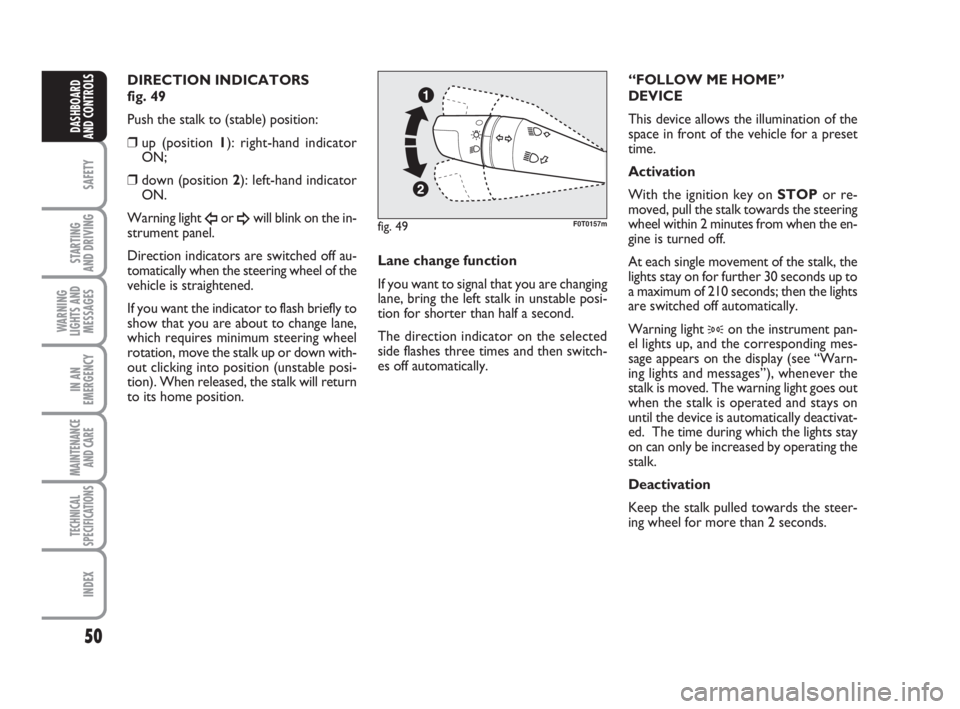
50
SAFETY
STARTING
AND DRIVING
WARNING
LIGHTS AND
MESSAGES
IN AN
EMERGENCY
MAINTENANCE
AND CARE
TECHNICAL
SPECIFICATIONS
INDEX
DASHBOARD
AND CONTROLS
DIRECTION INDICATORS
fig. 49
Push the stalk to (stable) position:
❒up (position 1): right-hand indicator
ON;
❒down (position 2): left-hand indicator
ON.
Warning light
Îor ¥will blink on the in-
strument panel.
Direction indicators are switched off au-
tomatically when the steering wheel of the
vehicle is straightened.
If you want the indicator to flash briefly to
show that you are about to change lane,
which requires minimum steering wheel
rotation, move the stalk up or down with-
out clicking into position (unstable posi-
tion). When released, the stalk will return
to its home position.Lane change function
If you want to signal that you are changing
lane, bring the left stalk in unstable posi-
tion for shorter than half a second.
The direction indicator on the selected
side flashes three times and then switch-
es off automatically.“FOLLOW ME HOME”
DEVICE
This device allows the illumination of the
space in front of the vehicle for a preset
time.
Activation
With the ignition key on STOPor re-
moved, pull the stalk towards the steering
wheel within 2 minutes from when the en-
gine is turned off.
At each single movement of the stalk, the
lights stay on for further 30 seconds up to
a maximum of 210 seconds; then the lights
are switched off automatically.
Warning light
3on the instrument pan-
el lights up, and the corresponding mes-
sage appears on the display (see “Warn-
ing lights and messages”), whenever the
stalk is moved. The warning light goes out
when the stalk is operated and stays on
until the device is automatically deactivat-
ed. The time during which the lights stay
on can only be increased by operating the
stalk.
Deactivation
Keep the stalk pulled towards the steer-
ing wheel for more than 2 seconds.
fig. 49F0T0157m
036-082 Fiorino GB 1ed:036-082 Fiorino GB 1ed 30-11-2009 15:47 Pagina 50
Page 73 of 210
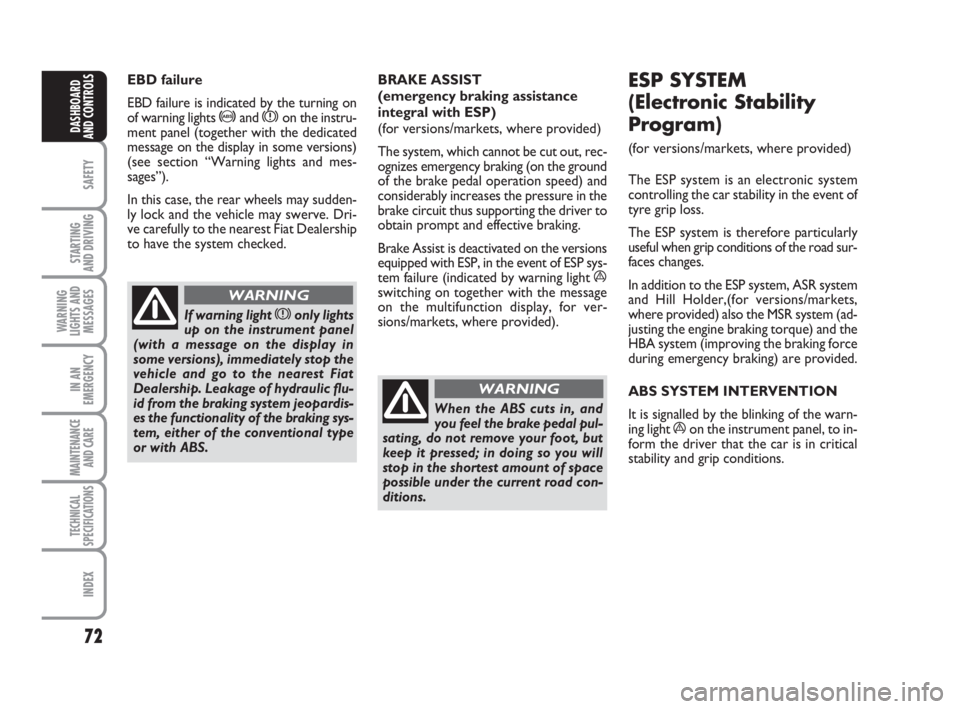
72
SAFETY
STARTING
AND DRIVING
WARNING
LIGHTS AND
MESSAGES
IN AN
EMERGENCY
MAINTENANCE
AND CARE
TECHNICAL
SPECIFICATIONS
INDEX
DASHBOARD
AND CONTROLS
If warning light xonly lights
up on the instrument panel
(with a message on the display in
some versions), immediately stop the
vehicle and go to the nearest Fiat
Dealership. Leakage of hydraulic flu-
id from the braking system jeopardis-
es the functionality of the braking sys-
tem, either of the conventional type
or with ABS.
WARNING
EBD failure
EBD failure is indicated by the turning on
of warning lights
>and xon the instru-
ment panel (together with the dedicated
message on the display in some versions)
(see section “Warning lights and mes-
sages”).
In this case, the rear wheels may sudden-
ly lock and the vehicle may swerve. Dri-
ve carefully to the nearest Fiat Dealership
to have the system checked.BRAKE ASSIST
(emergency braking assistance
integral with ESP)
(for versions/markets, where provided)
The system, which cannot be cut out, rec-
ognizes emergency braking (on the ground
of the brake pedal operation speed) and
considerably increases the pressure in the
brake circuit thus supporting the driver to
obtain prompt and effective braking.
Brake Assist is deactivated on the versions
equipped with ESP, in the event of ESP sys-
tem failure (indicated by warning light
áswitching on together with the message
on the multifunction display, for ver-
sions/markets, where provided).
ESP SYSTEM
(Electronic Stability
Program)
(for versions/markets, where provided)
The ESP system is an electronic system
controlling the car stability in the event of
tyre grip loss.
The ESP system is therefore particularly
useful when grip conditions of the road sur-
faces changes.
In addition to the ESP system, ASR system
and Hill Holder,(for versions/markets,
where provided) also the MSR system (ad-
justing the engine braking torque) and the
HBA system (improving the braking force
during emergency braking) are provided.
ABS SYSTEM INTERVENTION
It is signalled by the blinking of the warn-
ing light
áon the instrument panel, to in-
form the driver that the car is in critical
stability and grip conditions.
When the ABS cuts in, and
you feel the brake pedal pul-
sating, do not remove your foot, but
keep it pressed; in doing so you will
stop in the shortest amount of space
possible under the current road con-
ditions.
WARNING
036-082 Fiorino GB 1ed:036-082 Fiorino GB 1ed 30-11-2009 15:47 Pagina 72
Page 75 of 210
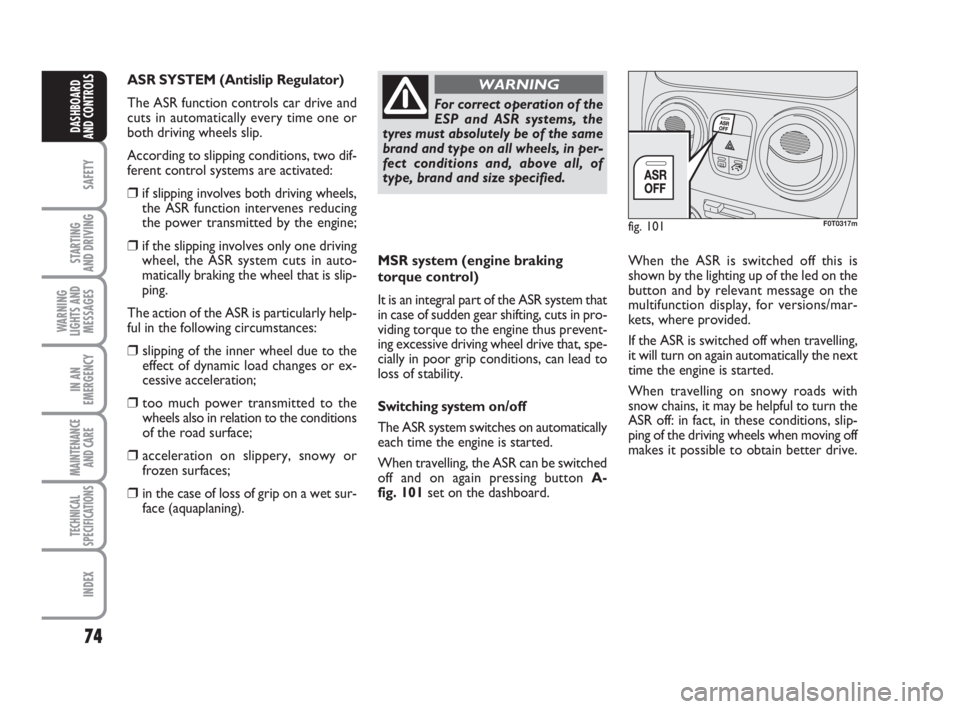
74
SAFETY
STARTING
AND DRIVING
WARNING
LIGHTS AND
MESSAGES
IN AN
EMERGENCY
MAINTENANCE
AND CARE
TECHNICAL
SPECIFICATIONS
INDEX
DASHBOARD
AND CONTROLS
MSR system (engine braking
torque control)
It is an integral part of the ASR system that
in case of sudden gear shifting, cuts in pro-
viding torque to the engine thus prevent-
ing excessive driving wheel drive that, spe-
cially in poor grip conditions, can lead to
loss of stability.
Switching systemon/off
The ASR system switches on automatically
each time the engine is started.
When travelling, the ASR can be switched
off and on again pressing button A-
fig. 101set on the dashboard. When the ASR is switched off this is
shown by the lighting up of the led on the
button and by relevant message on the
multifunction display, for versions/mar-
kets, where provided.
If the ASR is switched off when travelling,
it will turn on again automatically the next
time the engine is started.
When travelling on snowy roads with
snow chains, it may be helpful to turn the
ASR off: in fact, in these conditions, slip-
ping of the driving wheels when moving off
makes it possible to obtain better drive.
For correct operation of the
ESP and ASR systems, the
tyres must absolutely be of the same
brand and type on all wheels, in per-
fect conditions and, above all, of
type, brand and size specified.
WARNING
fig. 101F0T0317m
ASR SYSTEM (Antislip Regulator)
The ASR function controls car drive and
cuts in automatically every time one or
both driving wheels slip.
According to slipping conditions, two dif-
ferent control systems are activated:
❒if slipping involves both driving wheels,
the ASR function intervenes reducing
the power transmitted by the engine;
❒if the slipping involves only one driving
wheel, the ASR system cuts in auto-
matically braking the wheel that is slip-
ping.
The action of the ASR is particularly help-
ful in the following circumstances:
❒ slipping of the inner wheel due to the
effect of dynamic load changes or ex-
cessive acceleration;
❒ too much power transmitted to the
wheels also in relation to the conditions
of the road surface;
❒ acceleration on slippery, snowy or
frozen surfaces;
❒ in the case of loss of grip on a wet sur-
face (aquaplaning).
036-082 Fiorino GB 1ed:036-082 Fiorino GB 1ed 30-11-2009 15:47 Pagina 74
Page 116 of 210
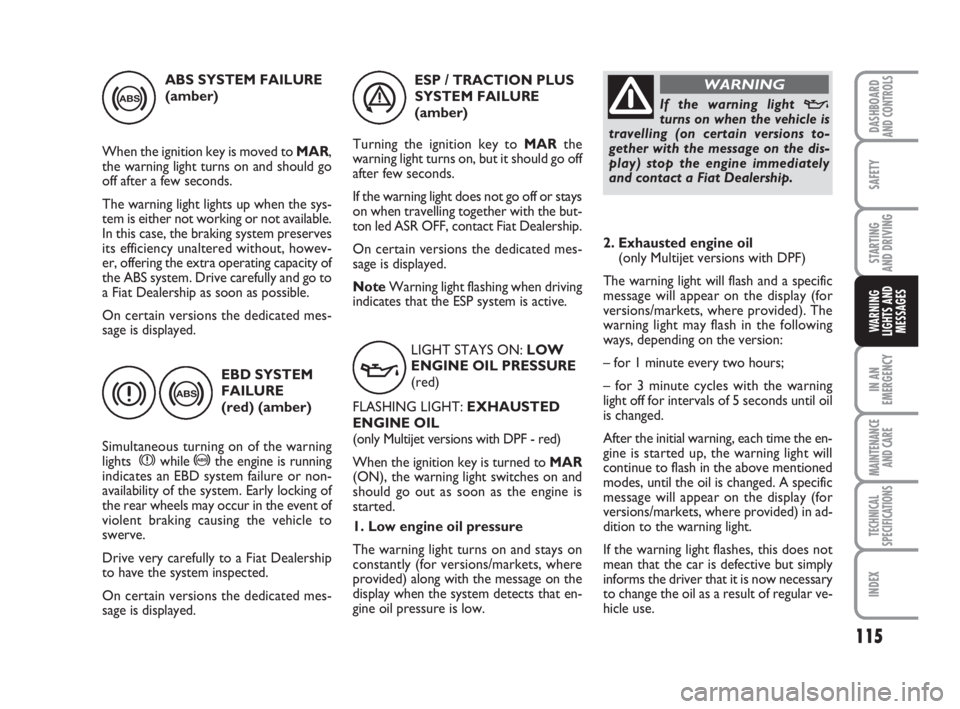
115
SAFETY
IN AN
EMERGENCY
MAINTENANCE
AND CARE
TECHNICAL
SPECIFICATIONS
INDEX
DASHBOARDAND CONTROLS
STARTING
AND DRIVING
WARNING
LIGHTS AND
MESSAGES
ABS SYSTEM FAILURE
(amber)
When the ignition key is moved to MAR,
the warning light turns on and should go
off after a few seconds.
The warning light lights up when the sys-
tem is either not working or not available.
In this case, the braking system preserves
its efficiency unaltered without, howev-
er, offering the extra operating capacity of
the ABS system. Drive carefully and go to
a Fiat Dealership as soon as possible.
On certain versions the dedicated mes-
sage is displayed.
EBD SYSTEM
FAILURE
(red) (amber)
Simultaneous turning on of the warning
lights
xwhile >the engine is running
indicates an EBD system failure or non-
availability of the system. Early locking of
the rear wheels may occur in the event of
violent braking causing the vehicle to
swerve.
Drive very carefully to a Fiat Dealership
to have the system inspected.
On certain versions the dedicated mes-
sage is displayed.
>
x>
v
LIGHT STAYS ON: LOW
ENGINE OIL PRESSURE
(red)
FLASHING LIGHT: EXHAUSTED
ENGINE OIL
(only Multijet versions with DPF - red)
When the ignition key is turned to MAR
(ON), the warning light switches on and
should go out as soon as the engine is
started.
1. Low engine oil pressure
The warning light turns on and stays on
constantly (for versions/markets, where
provided) along with the message on the
display when the system detects that en-
gine oil pressure is low.ESP / TRACTION PLUS
SYSTEM FAILURE
(amber)
Turning the ignition key to MARthe
warning light turns on, but it should go off
after few seconds.
If the warning light does not go off or stays
on when travelling together with the but-
ton led ASR OFF, contact Fiat Dealership.
On certain versions the dedicated mes-
sage is displayed.
NoteWarning light flashing when driving
indicates that the ESP system is active.
áIf the warning light vturns on when the vehicle is
travelling (on certain versions to-
gether with the message on the dis-
play) stop the engine immediately
and contact a Fiat Dealership.
WARNING
2. Exhausted engine oil
(only Multijet versions with DPF)
The warning light will flash and a specific
message will appear on the display (for
versions/markets, where provided). The
warning light may flash in the following
ways, depending on the version:
– for 1 minute every two hours;
– for 3 minute cycles with the warning
light off for intervals of 5 seconds until oil
is changed.
After the initial warning, each time the en-
gine is started up, the warning light will
continue to flash in the above mentioned
modes, until the oil is changed. A specific
message will appear on the display (for
versions/markets, where provided) in ad-
dition to the warning light.
If the warning light flashes, this does not
mean that the car is defective but simply
informs the driver that it is now necessary
to change the oil as a result of regular ve-
hicle use.
111-122 Fiorino GB 1ed:111-122 Fiorino GB 1ed 2-12-2009 16:18 Pagina 115
Page 126 of 210
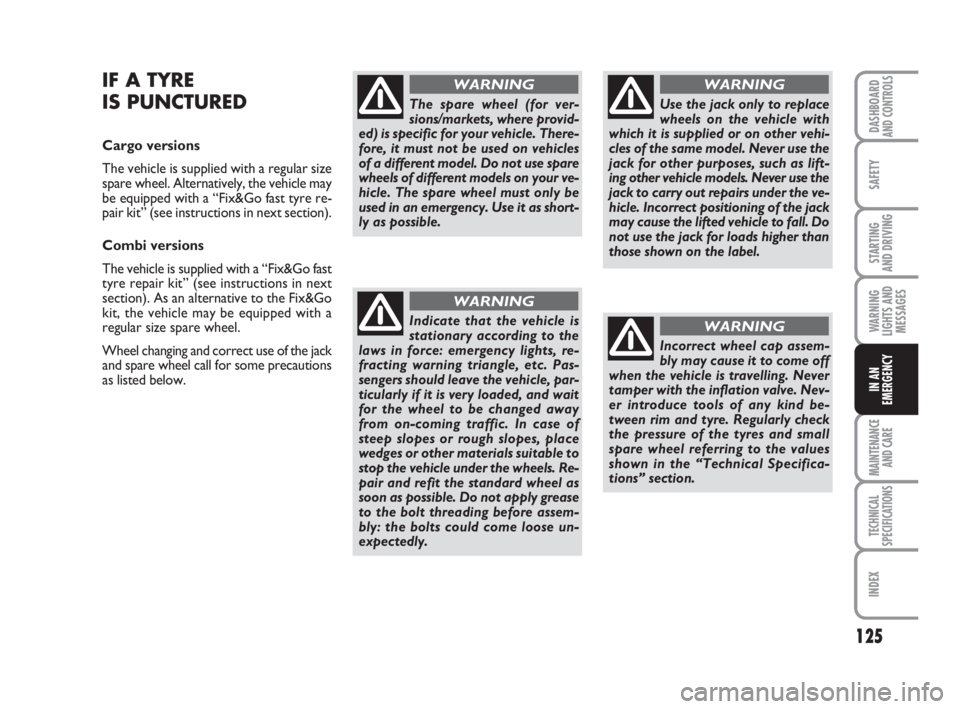
125
SAFETY
MAINTENANCE
AND CARE
TECHNICAL
SPECIFICATIONS
INDEX
DASHBOARDAND CONTROLS
STARTING
AND DRIVING
WARNING
LIGHTS AND
MESSAGES
IN AN
EMERGENCY
IF A TYRE
IS PUNCTURED
Cargo versions
The vehicle is supplied with a regular size
spare wheel. Alternatively, the vehicle may
be equipped with a “Fix&Go fast tyre re-
pair kit” (see instructions in next section).
Combi versions
The vehicle is supplied with a “Fix&Go fast
tyre repair kit” (see instructions in next
section). As an alternative to the Fix&Go
kit, the vehicle may be equipped with a
regular size spare wheel.
Wheel changing and correct use of the jack
and spare wheel call for some precautions
as listed below.
The spare wheel (for ver-
sions/markets, where provid-
ed) is specific for your vehicle. There-
fore, it must not be used on vehicles
of a different model. Do not use spare
wheels of different models on your ve-
hicle. The spare wheel must only be
used in an emergency. Use it as short-
ly as possible.
WARNING
Indicate that the vehicle is
stationary according to the
laws in force: emergency lights, re-
fracting warning triangle, etc. Pas-
sengers should leave the vehicle, par-
ticularly if it is very loaded, and wait
for the wheel to be changed away
from on-coming traffic. In case of
steep slopes or rough slopes, place
wedges or other materials suitable to
stop the vehicle under the wheels. Re-
pair and refit the standard wheel as
soon as possible. Do not apply grease
to the bolt threading before assem-
bly: the bolts could come loose un-
expectedly.
WARNING
Use the jack only to replace
wheels on the vehicle with
which it is supplied or on other vehi-
cles of the same model. Never use the
jack for other purposes, such as lift-
ing other vehicle models. Never use the
jack to carry out repairs under the ve-
hicle. Incorrect positioning of the jack
may cause the lifted vehicle to fall. Do
not use the jack for loads higher than
those shown on the label.
WARNING
Incorrect wheel cap assem-
bly may cause it to come off
when the vehicle is travelling. Never
tamper with the inflation valve. Nev-
er introduce tools of any kind be-
tween rim and tyre. Regularly check
the pressure of the tyres and small
spare wheel referring to the values
shown in the “Technical Specifica-
tions” section.
WARNING
123-154 Fiorino GB 1ed:123-154 Fiorino GB 1ed 3-12-2009 15:33 Pagina 125
Page 127 of 210

126
SAFETY
MAINTENANCE
AND CARE
TECHNICAL
SPECIFICATIONS
INDEX
DASHBOARDAND CONTROLS
STARTING
AND DRIVING
WARNING
LIGHTS AND
MESSAGES
IN AN
EMERGENCY
Important notes:
❒the jack weight is 1.76 kg;
❒the jack requires no adjustment;
❒the jack cannot be repaired. If it breaks
it must be replaced with a new jack;
❒no tool other than the cranking device
has to be fitted on the jack.To replace a tyre proceed as follows:
❒stop the vehicle in a position so that it
is not a danger for on-coming traffic in
a location where you can replace the
wheel safely. The ground must be flat
and compact.
❒Turn the engine off and pull up the
handbrake.
❒Engage first gear or reverse.
fig. 2F0T0119mfig. 3F0T0122m
❒Cargo versions:lift lever A-fig. 2and
move the backrest of the front seat for-
ward in order to take the tool box po-
sitioned behind the backrest. Release
the retention strap and position the box
near the tyre to be replaced.
❒Combi versions: open the rear swing
doors, take the tool bag fig. 3located
on the left side of the luggage com-
partment releasing the flexible retain-
ers and place it next to the wheel to be
changed;
123-154 Fiorino GB 1ed:123-154 Fiorino GB 1ed 3-12-2009 15:33 Pagina 126
Page 170 of 210
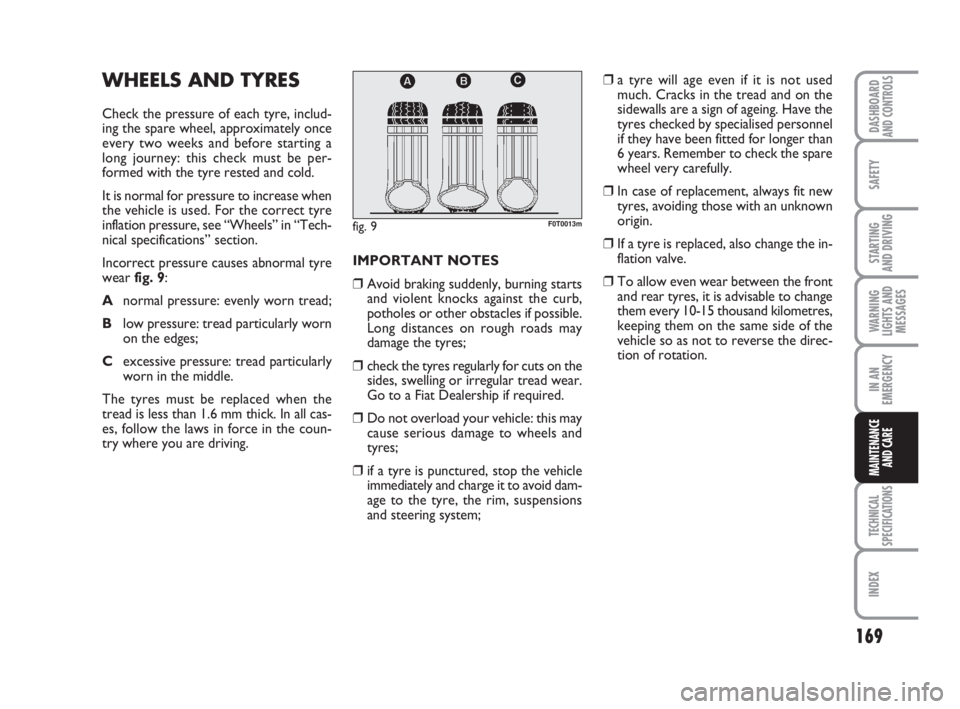
169
SAFETY
TECHNICAL
SPECIFICATIONS
INDEX
DASHBOARDAND CONTROLS
STARTING
AND DRIVING
WARNING
LIGHTS AND
MESSAGES
IN AN
EMERGENCY
MAINTENANCE
AND CARE
WHEELS AND TYRES
Check the pressure of each tyre, includ-
ing the spare wheel, approximately once
every two weeks and before starting a
long journey: this check must be per-
formed with the tyre rested and cold.
It is normal for pressure to increase when
the vehicle is used. For the correct tyre
inflation pressure, see “Wheels” in “Tech-
nical specifications” section.
Incorrect pressure causes abnormal tyre
wearfig. 9:
Anormal pressure: evenly worn tread;
Blow pressure: tread particularly worn
on the edges;
Cexcessive pressure: tread particularly
worn in the middle.
The tyres must be replaced when the
tread is less than 1.6 mm thick. In all cas-
es, follow the laws in force in the coun-
try where you are driving.IMPORTANT NOTES
❒Avoid braking suddenly, burning starts
and violent knocks against the curb,
potholes or other obstacles if possible.
Long distances on rough roads may
damage the tyres;
❒check the tyres regularly for cuts on the
sides, swelling or irregular tread wear.
Go to a Fiat Dealership if required.
❒Do not overload your vehicle: this may
cause serious damage to wheels and
tyres;
❒if a tyre is punctured, stop the vehicle
immediately and charge it to avoid dam-
age to the tyre, the rim, suspensions
and steering system;❒a tyre will age even if it is not used
much. Cracks in the tread and on the
sidewalls are a sign of ageing. Have the
tyres checked by specialised personnel
if they have been fitted for longer than
6 years. Remember to check the spare
wheel very carefully.
❒In case of replacement, always fit new
tyres, avoiding those with an unknown
origin.
❒If a tyre is replaced, also change the in-
flation valve.
❒To allow even wear between the front
and rear tyres, it is advisable to change
them every 10-15 thousand kilometres,
keeping them on the same side of the
vehicle so as not to reverse the direc-
tion of rotation.
fig. 9F0T0013m
155-176 Fiorino GB 1ed:155-176 Fiorino GB 1ed 30-11-2009 16:34 Pagina 169
Page 204 of 210
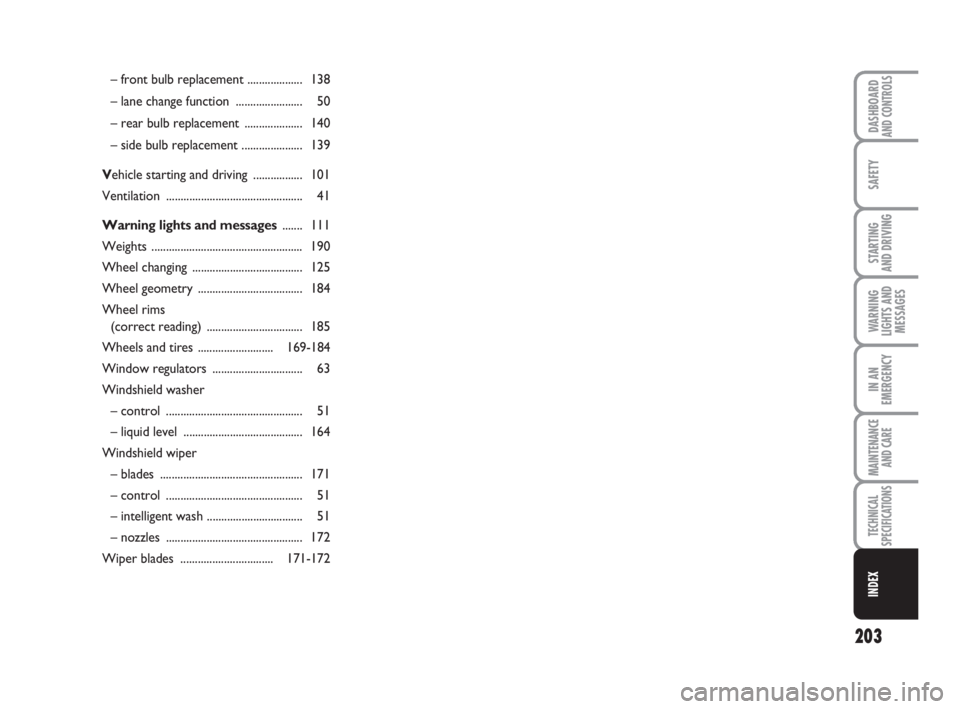
203
WARNING
LIGHTS AND
MESSAGES
DASHBOARDAND CONTROLS
SAFETY
STARTING
AND DRIVING
IN AN
EMERGENCY
MAINTENANCE
AND CARE
TECHNICAL
SPECIFICATIONS
INDEX
– front bulb replacement ................... 138
– lane change function ....................... 50
– rear bulb replacement .................... 140
– side bulb replacement ..................... 139
Vehicle starting and driving ................. 101
Ventilation ............................................... 41
Warning lights and messages....... 111
Weights .................................................... 190
Wheel changing ...................................... 125
Wheel geometry .................................... 184
Wheel rims
(correct reading) ................................. 185
Wheels and tires ..........................169-184
Window regulators ............................... 63
Windshield washer
– control ............................................... 51
– liquid level ......................................... 164
Windshield wiper
– blades ................................................. 171
– control ............................................... 51
– intelligent wash ................................. 51
– nozzles ............................................... 172
Wiper blades ................................171-172
200-208 Fiorino GB 1ed:202-208 Fiorino GB 1ed 2-12-2009 16:32 Pagina 203